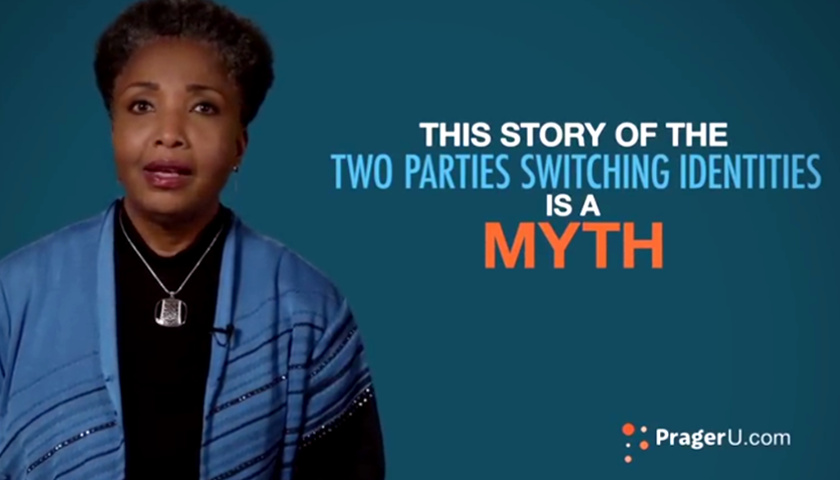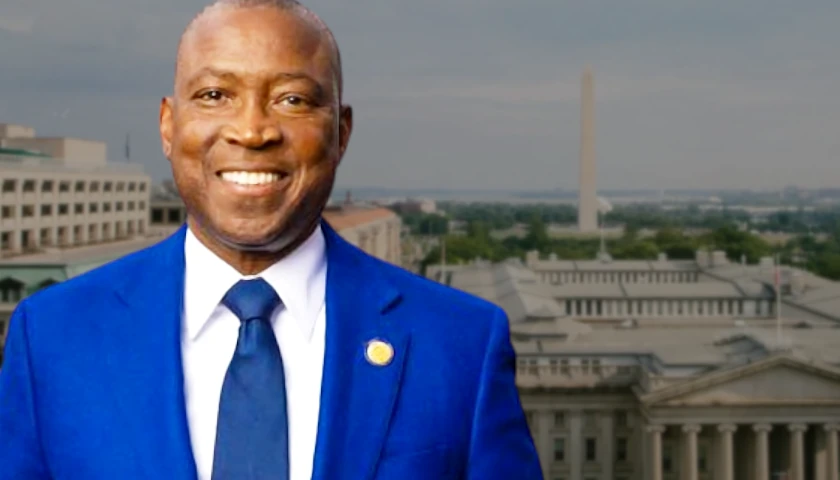by Dr. Carol Swain
Princeton Professor Kevin Kruse’s May 7, Twitter streamed attack on one of my Prager University videos (“Why did the Democratic South become Republican?”) comes at a time when some blacks in America are beginning to question the Democratic Party’s history and intentions.
The attack also comes at a time when Prager University has a pending appeal with the Ninth Circuit Court challenging Google for selectively demonetizing about 50 of its conservative YouTube videos. So much is at stake for the Democratic Party, that the Prager videos have caused the left-wing Southern Poverty Law Center to cite the Twitter stream in a fresh attack on Prager University for its ability to reach millions with its five-minute videos. The Left often coordinates its attacks in a manner meant to discredit and discourage inquiry.
Professor Kruse’s criticism deserves a response and so do Prager University subscribers. After carefully reviewing his data and its claims, I stand behind the substantive message of my Prager University video. I will, however, concede the need to make a small correction about the date of President Eisenhower’s deployment of the 101st Airborne to Little Rock Arkansas to enforce desegregation, the deployment of troops occurred after the 1956 elections in which Eisenhower expanded his 1952 support in southern states.
Professor Kruse cites scattered newspaper articles and quotes by individual Republicans who in some cases made statements we would consider racist or by those in Alabama who voted against the 1964 Civil Rights Act. While this information is interesting, it is not contested by me nor directly applicable to the arguments I make in the short video. Given that candidates run as individuals, it would hardly be surprising that a search of individual campaigns would reveal Republican candidates acting like politicians and embracing unpalatable positions.
Before deciding that the Republican Party had to tap into racism to win in the South, it behooves us to review exactly what was happening in the nation. By the mid-1960s, Christians were reeling from Supreme Court decisions that had taken both prayer (1962) and Bible reading (1963) out of public schools, radical Marxists were bombing buildings and killing law enforcement officers, and violently attacked American institutions. Urban riots, the sexual revolution, rising black militancy, anti-war protests, and the Democratic Party’s seeming coziness with radicals would have been a turnoff to many Americans within and outside the South.
Professors Richard Johnston and Byron Shafer in their 2009 book, The End of Southern Exceptionalism used surveys and election data to show that the poorest whites remained loyal to the Democratic Party until the 1990s. Johnston and Shafer concluded that economic growth, not race, explains how the postwar South was transformed. They show that as early as the 1950s, high income voters gave majority support to Republican presidential candidates, whereas the lower income whites supported Democrats and continued to do so until the 1990s.
Professor Kruse tweets: “While Goldwater lost in a landslide defeat to LBJ that fall, [1964] he did succeed in winning five states in the deep South. Unlike previous Republicans who cracked the South, Goldwater won by appealing not to moderate whites and African Americans but to conservatives.” The implication is that Goldwater won by appealing to racists rather than the more likely fact that his principled positions articulated in his classic 1960 book, The Conscience of a Conservative, resonated with voters concerned about the chaos in the nation. Goldwater’s book addressed important societal issues like education, civil rights, social welfare, and income taxes from a conservative perspective.
Goldwater made no overt or subtle appeals to racism. Rather, he was a constitutionalist. When casting his historic vote against the 1964 Civil Rights Act, Goldwater affirmed his lifelong support of racial integration. A review of a biography in The New Yorker states:
Goldwater was not a segregationist, nor was he any kind of racist. He was, in fact, a lifelong opponent of racial discrimination. At the beginning of his political career, as a city councilman, he had led the fight to end segregation in the Phoenix public schools; his first staff assistant when he went to the Senate, as Perlstein tells us, was a black woman; he was a member of the N.A.A.C.P. Goldwater voted against the Civil Rights Act because he believed, as a conservative, that the federal government did not have the power to compel states to conform to its idea of racial equality, or to dictate to individuals whom they must associate with.
The fact that some racist whites voted for Goldwater in hopes that he might stall integration says nothing about his character or Republican Party politics at the national level. Among those southern Goldwater voters were citizens who shared his strong views on the Constitution and found themselves troubled by what they saw as a violation of the document. It is impossible to disentangle the racist voters in the south from the principled conservatives in the case of the 1964 election.
Professor Kruse subsequently points out that George Wallace, running as an independent, won the deep South in 1968. In the eyes of the voters George Wallace, who blocked black students from entering the University of Alabama auditorium, was a disgruntled Democrat. Wallace, an opportunist, ran as an independent with the intent of winning enough electoral votes to force the House of Representatives to decide the election. The whites who voted for him were Democrats voting for one of their own. It should also be noted that Wallace sought the Democratic nomination in 1972. Wallace won the southern primaries handily, as well as, northern primaries in Michigan and Maryland. His efforts to secure the nomination were cut short after an assassination attempt in May of 1972. Had the attempt on his life not occurred, Wallace would have had a real shot at becoming the Democratic nominee for President.
Professor Kruse lifts a quote from my 2002 book, The New White Nationalism in America: Its Challenge to Integration, to show that I had written about the Republican use of a “Southern Strategy” following the election of Wallace. In my defense, I was a Democrat who naturally accepted the books and articles written mostly by scholars who like me were Democrats. It was taken as the gospel that the Republican gains in the South vote were attributable to their ability to win the votes of racist whites by using code words and symbols. Consequently, Nixon’s calls for law and order, his opposition to forced busing and expansions of the welfare state were dog whistles for racist whites. Right? Maybe not. What if those topics were and are legitimate topics of conversation that many people outside the Ivy Tower could find agreement on the objective merits? Many Americans were concerned about the lawlessness and chaos of the 1960s. Black and white parents came to disdain bussing, and the expansion of the welfare state under liberal Democrats has harmed black Americans.
Professor Kruse also conveniently fails to mention Richard Nixon’s long history of supporting civil rights, affirmed in his support of the 1967, Philadelphia Plan adopted to address discrimination in the construction industry. Some scholars, for example, John Skrentny, have characterized Nixon’s support of racial quotas as a calculated effort to break apart the Democratic coalition between blacks, Jews, and union workers. It was Republican elites who sustained and breathed life into affirmative action long before Democrats embraced the program.
Much of the finger-pointing and liberal arguments about Republicans hinge on words. In the “The Myth of Racist Republicans,” Professor Gerard Alexander points out the problem of the arguments about the codewords. He writes:
Like many others, Carter and the Black brothers argue that the GOP appealed to Southern racism not explicitly but through “coded” racial appeals. Carter is representative of many when he says that Wallace’s racialism can be seen, varying in style but not substance, in “Goldwater’s vote against the Civil Rights Bill of 1964, in Richard Nixon’s subtle manipulation of the busing issue, in Ronald Reagan’s genial demolition of affirmative action, in George Bush’s use of the Willie Horton ads, and in Newt Gingrich’s demonization of welfare mothers.”
The problem here is that Wallace’s segregationism was obviously racist, but these other positions are not obviously racist. This creates an analytic challenge that these authors do not meet. If an illegitimate viewpoint (racism) is hidden inside another viewpoint, that second view—to be a useful hiding place—must be one that can be held for entirely legitimate (non-racist) reasons. Conservative intellectuals might not always linger long enough on the fact that opposition to busing and affirmative action can be disguised racism. On the other hand, these are also positions that principled non-racists can hold. To be persuasive, claims of coding must establish how to tell which is which.
Working class white voters do have some legitimate issues that need to be addressed. Anger and frustration over racial preferences in education and the workplace, liberal immigration policies, and black-on-white crime were among the issues I identified in The New White Nationalism that were and are contributing to the rise of a new kind of white leader.
The new white nationalist now labels him or herself as a member of the alt-right. These are people who have adopted the style of minority civil rights leaders and who openly urge white people to see themselves as having a distinct racial interest. I believe the emergence of the alt-right is a direct result of the Democratic Party utilizing identity politics to pit racial and ethnic groups against each other, as well as, their unwillingness to address legitimate policy concerns in a race neutral manner. Under the liberal policies of the Democrats, the black abortion rate, the unwed motherhood rate, and the black-on-black crime rate have skyrocketed.
Fortunately, today a younger generation of blacks are beginning to explore and question the histories and policy outputs of the two political parties. We now have Candace Owens and Kanye West actively seeking to awaken a younger generation to the fact that there are real party differences that matter and that it is okay for them to break allegiance to the party of their parents. When Republican leaders are true to their party platform, they can and do attract freedom-loving Americans who respect and honor the U.S. Constitution.
This response to Professor Kruse’s Twitter stream should serve to set the record straight about the challenged Prager U video, which was never intended to be a treatise on the southern strategy. One need only to watch the video to see that Professor Kruse went far beyond the video in his creative attack. My Prager University video sought to answer how the South became Republican. It was informed by Johnston’s and Shafer’s path-breaking research documenting the role of economic growth in fueling the rise of southern Republicanism. Many of us have learned that the research produced by liberal Democratic scholars with vested interests has been anything but neutral.
– – –
Carol M. Swain is a former associate professor of politics at Princeton University and former professor of political science and law at Vanderbilt University. Her forthcoming new book is Debating Immigration: Second Edition (forthcoming, July 2018). Facebook: Profcarolmswain Twitter: @carolmswain E-mail: [email protected]




